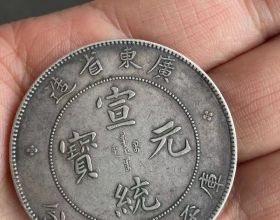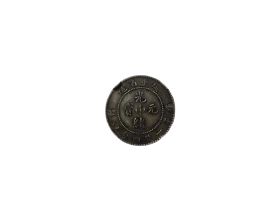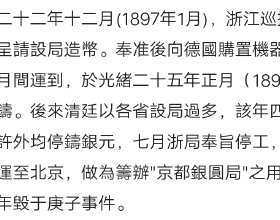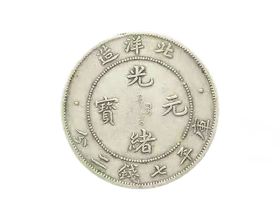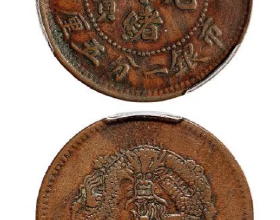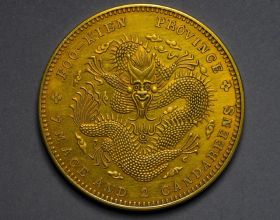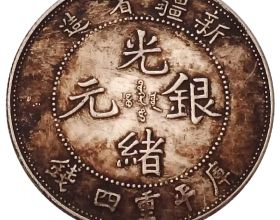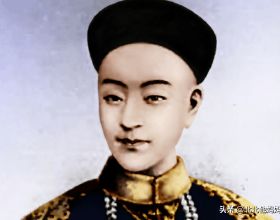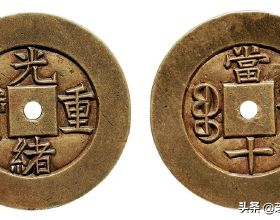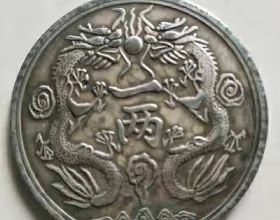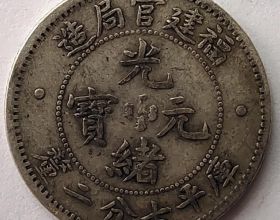清代銀幣、紙鈔、銅幣並行,至嘉慶年間發行新式銀元,而光緒年間鑄行金、銀幣更多。洋務運動也影響到鑄幣業,兩廣總督張之洞曾於光緒十三年(1887年)委託使英大臣在英國訂購全套造幣機器,並在廣東錢局首鑄機制銀元和銅元。其後,各省紛紛仿效,購制國外機械鑄造銀、銅元。包括廣東錢局在內,許多造幣機均訂購自著名的英國倫敦伯明翰造幣有限公司。英國大工業的介入,使銀幣也沾染上西方色彩。錢幣正面顯然可見滿漢文化的融合,而錢背卻明確標示了西方文化的介入。
清末銅價劇漲,民間毀錢為銅,以獲數倍之利,市面出現錢荒。廣東因停鑄制錢,市面制錢日乏,小額流通十分不便。為救錢荒,同時受香港銅元及外幣影響,光緒26年6月,兩廣總督德壽與前總督李鴻章奏準廣東仿香港銅仙鑄造機制銅元。故清代機制銅元的鑄造由廣東伊始。繼而福建、江蘇、四川等省相繼仿鑄銅元。
一直以來,中國人都有儲存錢幣的習慣,有的可能是為了投資,有的可能就是單純的喜歡,有的則是為了蓋房子。眾所周知,古人建房子,都會在房樑上懸掛一串銅錢,表達對興旺發家的一種美好祝福。如今,大家使用的都是紙幣,沒有以往的錢幣,但並不妨礙眾人收藏錢幣。再者,古錢幣有一個熱點就是珍貴、價值高,有的單枚就能賣到幾百萬的價格,這對於某些人來說,無疑是一個很好的投資機會。
湖北省造光緒元寶當十
錢幣背面上下環英文,正中鑄蟠龍圖,眼神靈異炯炯有神,龍爪張揚,龍鱗雕刻細密有致,騰雲駕霧,身姿遒勁有力。龍在中國傳統文化中是權勢、高貴、尊榮的象徵。該枚光緒元寶是不可多得的收藏佳品,具有巨大的收藏價值及投資價值。
火龍版:背面可以看見像山字一樣的火焰紋,火龍在錢幣中還是很少見的,一般水龍會多見,上下數千年,龍已滲透了中國社會的各個方面,成為一種文化的凝聚和積澱。龍成了中國的象徵、中華民族的象徵、中國文化的象徵。對每一個炎黃子孫來說,龍的形象是一種符號、一種意緒、一種血肉相聯的情感。“龍的子孫”、“龍的傳人”這些稱謂,常令我們激動、奮發、自豪。在中國,收藏家極其喜歡龍紋錢幣,因為民間傳說,“大清銅幣”背面的龍能增加一個人的氣運,使其時刻在龍氣的保護下,趨吉避凶,此錢幣品相完美,包漿自然,底光柔和,是不可多得的稀有錢幣,具有極大的歷史研究價值以及經濟收藏價值。
湖北省造光緒元寶當十”一枚。錢幣正面頂部鑄楷體“湖北省造”四字,中心直讀“光緒元寶”四字,並裝飾六瓣花星,兩側為滿文;底部鑄貨幣價值“當十”二字。文字行雲流水,端秀清新,品相精緻,其審美風格獨特。
這枚錢幣包漿自然,底光柔和,所謂包漿是自然形成的氧化層,也有人為手盤包漿,兩者不同,但同時都有保護錢幣的功能,有如給錢幣鍍上一層保護膜,使錢幣不再氧化,便於收藏傳世,如果覺得錢幣髒,可以用清水洗,再用棉布擦乾,不要破壞包漿,破壞了包漿就相當於破壞了保護層,更重要的是包漿是鑑定新老錢幣最簡單有效的方法。細看這枚錢幣品相完美,沒有磕缺,損毀,變形等是不可多得的收藏級銅幣,建議收藏,傳世。
英文翻譯:n the Qing Dynasty, silver coins, banknotes and copper coins were issued in parallel. New silver dollars were issued during the Jiaqing Reign, while more gold and silver coins were cast during the Guangxu reign. The Westernization Movement also affected the coinage industry. In the 13th year of Guangxu (1887), Zhang Zhidong, the governor of Guangdong and Guangdong, commissioned British ministers to order a full set of mint machines in Britain, and made the first silver and copper coins in the Guangdong Money Bureau. Subsequently, the provinces followed suit and bought foreign machinery to cast silver and copper. Many mint machines, including the Guangdong Mint Bureau, were ordered from the famous London Birmingham Mint Co., LTD. The intervention of great British industry made silver coins also have a Western color. The front of the coin clearly shows the fusion of Manchu and Han cultures, while the back of the coin clearly indicates the intervention of Western culture.
At the end of the Qing Dynasty, copper prices rose dramatically, and the folk destroyed money for copper, in order to obtain several times the profit, the market appeared money shortage. Guangdong stopped casting money, money market day lack, small circulation is very inconvenient. In order to save the money shortage and the influence of Hong Kong copper dollar and foreign currency, in June 26, Guangxu, Governor De Shou and former governor Li Hongzhang played the imitation of Hong Kong copper coin casting mechanism in Guangdong. Therefore, the casting of copper coins in the Qing Dynasty began in Guangdong. Then Fujian, Jiangsu, Sichuan and other provinces have imitation casting copper.
Chinese people have long been storing coins, some for investment, some for pleasure, and some for building houses. As we all know, when building a house, the ancients would hang a string of copper coins on the beam to express a good wish for prosperity. Today, everyone is using paper money, there is no money in the past, but it does not prevent people from collecting money. Moreover, ancient coins have a hot spot that is precious and high value. Some single coins can sell for millions of dollars, which is undoubtedly a good investment opportunity for some people.
Hubei province made Guangxu yuanbao when ten
English is circled on the back of the coin, and the dragon is cast in the middle. The eyes are bright and vivid, the dragon claw is made public, the dragon scales are finely carved, and the body is powerful and vigorous. Dragon is a symbol of power, nobility and honor in traditional Chinese culture. The Guangxu ingot is a rare collection, with huge collection value and investment value.
Fire dragon version: the back can see the flame pattern like the mountain word, fire dragon is still very rare in the coin, the general water dragon will see more, up and down for thousands of years, the dragon has penetrated into all aspects of Chinese society, become a kind of cultural cohesion and accumulation. The dragon has become the symbol of China, the Chinese nation and the Chinese culture. To every Chinese descendant, the image of the dragon is a symbol, a mood, and an emotion connected with flesh and blood. "Descendants of the dragon", "descendants of the dragon" these terms often make us excited, strenuous, proud. Dragon coin collector in China, very like, because of folklore, "qing coppers" on the back of the dragon can increase a person's fate, the time on the dragon under the protection of gas,, and avoid the coin is in perfect, patina natural and downy light, is rare rare coin, the history of great research value and economic value for collection.
Hubei province made Guangxu yuan Bao when ten "a. The top side of the coin is cast in regular script "Made in Hubei Province", and the center reads the four words "Guangxu Yuanbao" directly, and is decorated with six flower stars, and both sides are Manchu; Bottom cast currency value "when ten" two words. The text flows smoothly, the end show is fresh, the product looks delicate, its aesthetic style is unique.
This coin patina nature, the bottom light is downy, so-called wrapped slurry is a natural formation of the oxide layer, also some people to hand wrapped slurry, the two different, but at the same time have to protect the function of money, like a plated coin on a layer of protective film, make money no longer oxidation, facilitate collection handed down from ancient times, if feel money is dirty, can wash, reoccupy cloth wipe, do not destroy the wrapped slurry, The destruction of patina is equivalent to the destruction of the protective layer, and more importantly, patina is the simplest and effective way to identify new and old coins. Take a close look at this coin with perfect appearance, no damage, damage, deformation and so on. It is a rare collectible copper coin. It is recommended to collect and pass on.




